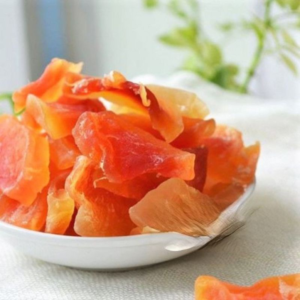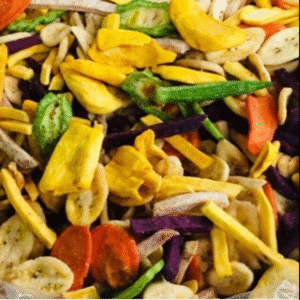Last updated on May 5th, 2025 at 06:17 am
Introduction
Importing bulk dried papaya has become a smart move for international buyers as global dried fruit consumption is projected to grow at 5.9% annually according to Statista (opens new tab). Vietnam, known for its tropical climate and agricultural expertise, is one of the top exporters of high-quality dried papaya. In this detailed guide, we will walk you through every step to successfully import bulk dried papaya, helping you make informed sourcing decisions and streamline your supply chain.
Discover OEM/ODM dried papaya options.
Step 1: Understand the Product Specification
Before sourcing, it’s crucial to know the typical specifications of bulk dried papaya from Vietnam.
| Specification | Range |
|---|---|
| Moisture Content | 12%–18% |
| Sugar Content | 14%–38% (depending on sweetened/unsweetened) |
| Size | 5–12 cm slices, diced, or strips |
| Packaging | 5kg, 10kg, or 20kg bulk cartons |
| Shelf Life | 9–12 months |
Knowing these details ensures you can define clear requirements to suppliers.
Learn about the different types of dried papaya available.

Step 2: Choose the Right Dried Papaya Type
Vietnamese dried papaya comes in two main varieties:
- Sweetened Dried Papaya: Ideal for snack manufacturers and confectionery businesses.
- Unsweetened Dried Papaya: Popular among organic, health-focused brands.
Quick comparison table:
| Type | Ideal For | Sugar Level |
|---|---|---|
| Sweetened | Snack foods, candies | 35%-55% |
| Unsweetened | Health food products | 10%-18% |
Explore sweetened vs unsweetened dried papaya differences.
Step 3: Identify Reliable Suppliers
Choosing the right supplier is critical for successful imports. Key factors include:
- Certifications: Suppliers should hold HACCP, ISO 22000 certifications to guarantee food safety and quality.
- Production Capacity: Ensure monthly output meets your quantity needs (recommended: >20 tons/month).
- Traceability Systems: Suppliers should provide full traceability from raw material to finished product.
Vietnamese manufacturers like Qualitex Global offer OEM/ODM services for bulk dried papaya sourcing.
Step 4: Verify Product Quality
Before finalizing a deal, you should request:
- Samples: Always inspect samples for color, moisture, texture, and taste.
- Lab Testing Reports: Verify microbiological safety (e.g., absence of Salmonella, E. coli).
- Factory Audit Reports: Confirm hygiene, facilities, and processing standards.
Understand shelf life and proper storage for dried papaya to maintain quality post-import.
Step 5: Negotiate Contract Terms
When negotiating with your supplier:
- Define MOQ (Minimum Order Quantity): Typically starts at 1 ton for bulk shipments.
- Set Payment Terms: Standard practices include 30% deposit, 70% before shipment.
- Confirm Incoterms: FOB (Free on Board) or CIF (Cost, Insurance, Freight) are most common.
For smooth transactions, work with suppliers experienced in exporting dried papaya in large quantities.
Step 6: Arrange Shipping and Logistics
Shipping dried papaya internationally involves:
| Aspect | Details |
|---|---|
| Packaging | Bulk cartons with inner food-grade PE liner |
| Transport Mode | Sea freight preferred for cost efficiency |
| Lead Time | 20–35 days depending on destination |
Consider Vietnam’s major ports such as Cat Lai and Hai Phong for easier container handling.
Find out how dried papaya shelf life is preserved during transport.
Step 7: Customs Clearance and Import Regulations
Key import documents required include:
- Commercial Invoice
- Packing List
- Certificate of Origin (Form B, if FTA benefits)
- Phytosanitary Certificate
Tip: Hiring a licensed customs broker can expedite clearance and prevent delays.
Understand the food safety standards applicable by referring to official government import regulations (US FDA Food Import Requirements).
Conclusion
Importing bulk dried papaya from Vietnam is a straightforward process when managed properly. By understanding product specs, choosing reliable suppliers, ensuring quality, and managing shipping and customs efficiently, importers can tap into the growing dried fruit market with confidence.
If you want to import dried papaya from Vietnam under private label or custom branding, partnering with an OEM/ODM manufacturer ensures consistent quality and timely delivery. For inquiries about importing high-quality dried papaya, contact Qualitex Global.
FAQ Section
What is the typical MOQ for importing bulk dried papaya?
Most suppliers set a minimum order quantity starting from 1 ton per order for bulk shipments.
How long does dried papaya last during shipping and storage?
Properly packed dried papaya can maintain quality for 9–12 months in cool, dry conditions.
Do I need specific certifications when importing dried papaya?
Yes, importing countries may require HACCP, phytosanitary certificates, and food safety documentation.
Can I order custom packaging for my bulk dried papaya shipments?
Yes, most Vietnamese suppliers like Qualitex Global offer OEM/ODM options including private label packaging.
Which Incoterms are commonly used for dried papaya import?
FOB and CIF terms are most commonly used for dried fruit imports from Vietnam.
What quality checks should I perform before importing?
Request product samples, lab reports, and verify supplier certifications before confirming the order.









